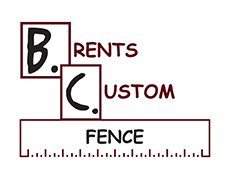Understanding the Investment: What Does Fencing Your Acre Really Cost?
Cost privacy fence 1 acre is a common question for homeowners planning a major property upgrade. The answer varies significantly based on your choices and property conditions.
Here’s what you need to know:
- Linear Footage: A square acre needs about 836 feet, but irregular shapes require more.
- Main Cost Drivers: Material, labor, fence height, site prep, gates, and permits.
- Timeline: Professional installation typically takes 4-7 days.
- Budget Option: Chain link with privacy slats or pressure-treated pine.
- Long-Term Value: Vinyl or composite offer lower maintenance.
Fencing an entire acre is a significant investment in your property’s privacy, security, and value. Unlike smaller projects, it requires careful planning and budgeting to avoid costly miscalculations.
Understanding all cost factors before getting quotes helps you spot fair pricing and avoid overpaying. Many homeowners focus only on materials and are surprised by labor rates, site prep needs, or permit fees. Choosing the cheapest option upfront can lead to expensive repairs later.
This guide breaks down everything influencing the total cost of fencing your acre. You’ll learn to calculate your needs, understand price drivers, and identify hidden expenses, empowering you to make confident decisions.
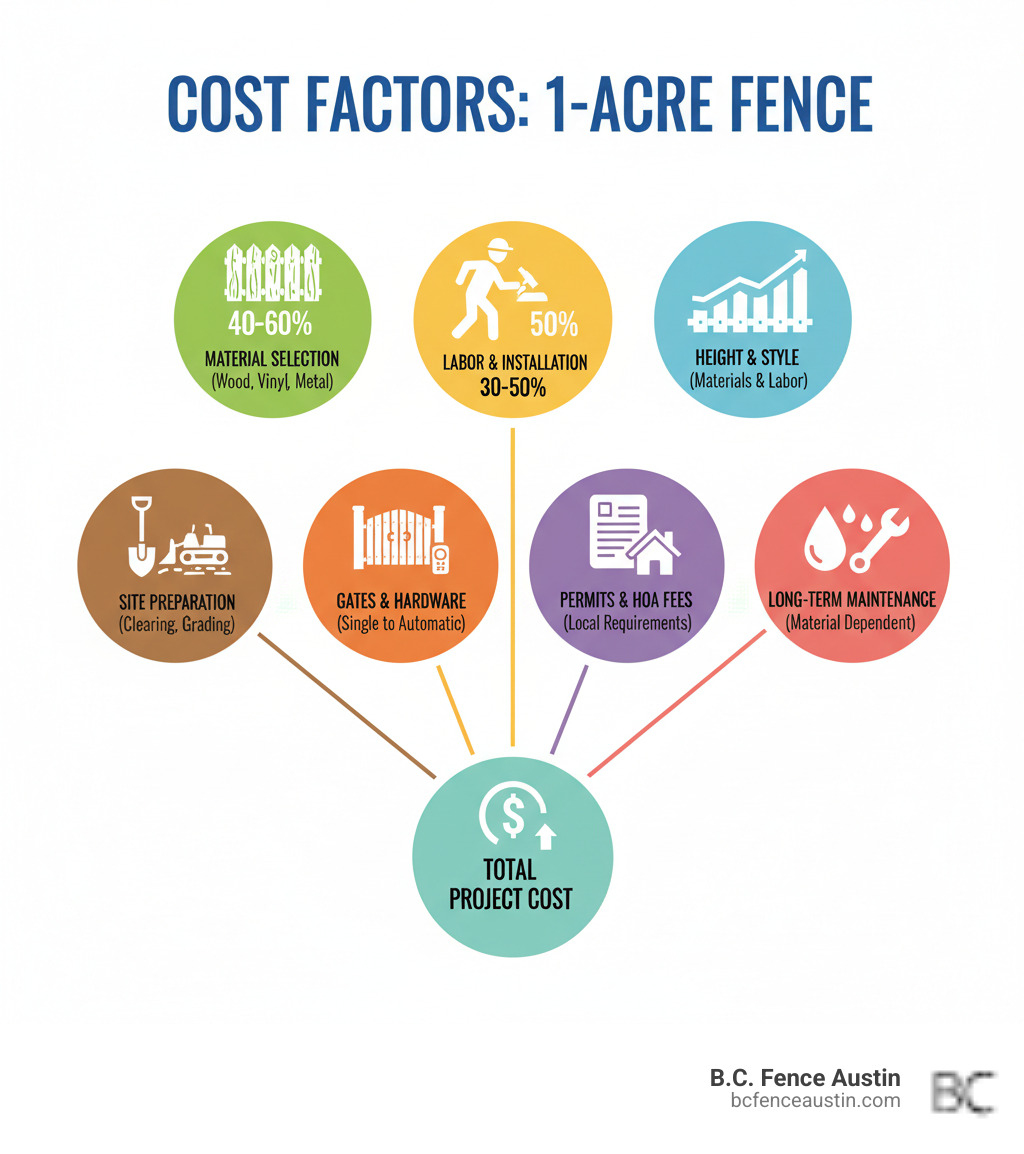
First, How Much Fencing Does One Acre Need?
Before estimating your cost privacy fence 1 acre, you must determine the total length of fencing required. The answer isn’t as simple as “one acre equals X feet of fence.”
An acre measures area (43,560 square feet), not perimeter. See Acre for background on the unit. The amount of fencing you need depends on the shape of your property.
A perfect square acre requires approximately 836 linear feet of fencing (about 208.7 feet per side). This is the most efficient shape, enclosing the most area with the least material.
However, most properties aren’t perfect squares. A long rectangular acre (e.g., 100 ft by 435.6 ft) would need about 1,071 linear feet. An irregularly shaped lot could require even more.
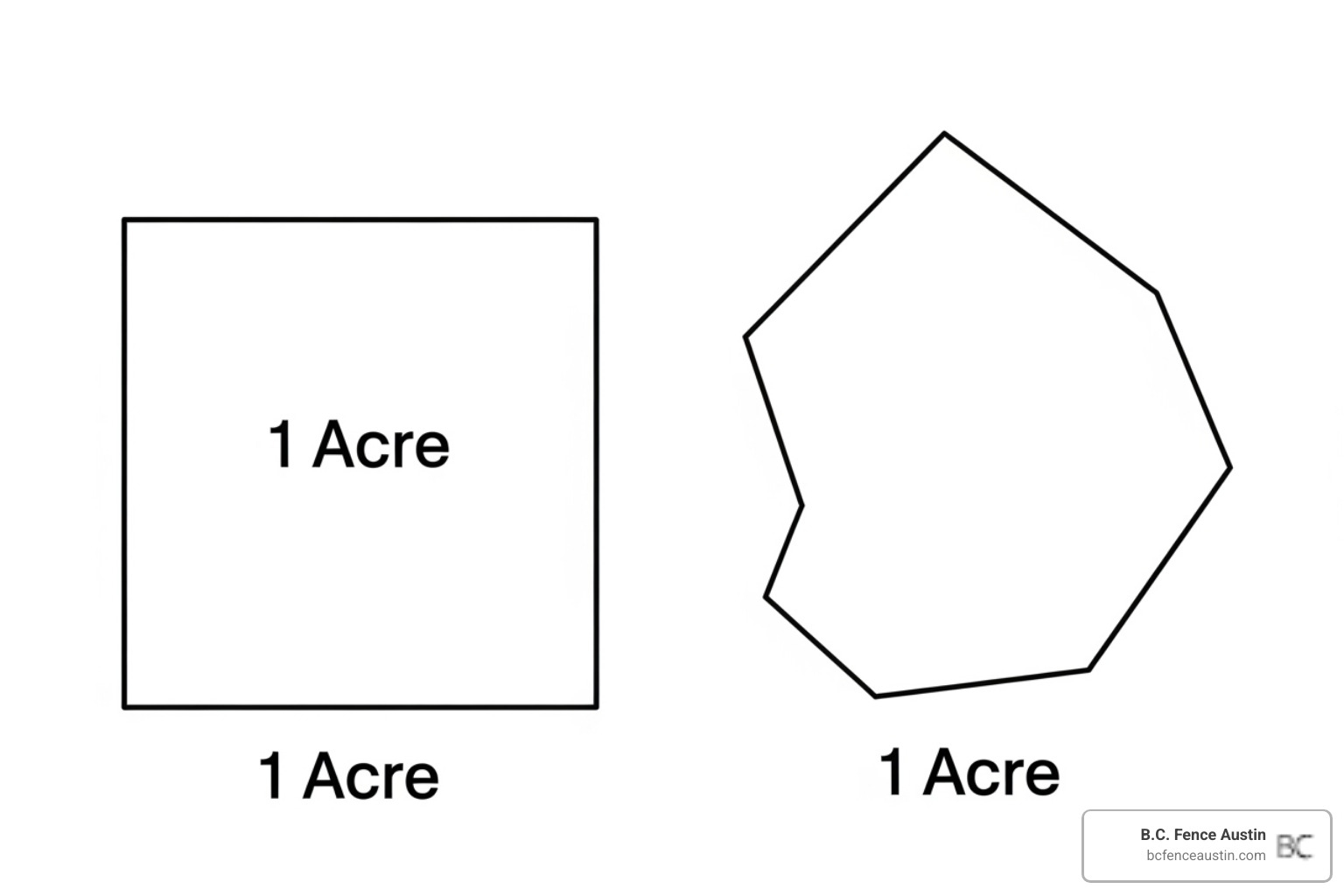
This is why a professional land survey is crucial before starting a large fencing project (see Land surveying for what a survey involves). A survey provides precise boundary measurements, preventing surprises during installation and avoiding neighbor disputes.
A survey also helps with practical planning, like optimal gate placement and identifying any easements or setback requirements. These details are vital for a project of this scale.
Having accurate measurements makes the quoting process smoother. Remember to account for gate placement in your calculations, as gates affect your total linear footage and project scope.
The bottom line: Professional measurement is essential for an accurate quote and preventing costly mistakes.
Key Factors That Determine Your Total Privacy Fence Cost
Once you know how much fencing you need, it’s time to understand what drives the cost privacy fence 1 acre. Three main elements will shape your final investment: the materials you choose, the complexity of installation, and the height and style of your fence. Let’s break down each one so you can plan your budget with confidence.
Material Selection: The Biggest Cost Driver
The material you pick will have the biggest impact on your cost privacy fence 1 acre. You’re balancing upfront costs with longevity and long-term maintenance.
| Material | Relative Cost | Lifespan | Maintenance Level |
|---|---|---|---|
| Wood (Treated Pine) | Budget-Friendly | Moderate | High |
| Wood (Cedar/Redwood) | Moderate | Moderate-High | Moderate |
| Vinyl | Moderate-High | High | Low |
| Composite | High | Very High | Very Low |
| Aluminum (Privacy) | High | Very High | Very Low |
| Chain Link w/ Slats | Budget-Friendly | Moderate-High | Low |
Wood fences are a classic choice. Pressure-treated pine is a budget-friendly option for large projects like fencing an acre. Cedar and redwood cost more but offer better natural resistance to rot and insects. The trade-off for wood is maintenance; it requires staining or sealing every few years. See how it compares in our guide on Vinyl Fences Versus Wood Fences.
Vinyl fences are popular for good reason. While the upfront cost is higher than treated pine, vinyl won’t rot, attract termites, or fade. Maintenance is simple: just an occasional rinse with a hose. This low upkeep can save money over time.
Composite fencing combines the look of wood with the durability of vinyl. Made from recycled wood fibers and plastic, it won’t splinter, rot, or require constant upkeep, making it a premium choice that pays off in longevity.
Aluminum privacy fences offer a sleek, modern look with outstanding durability. Unlike decorative aluminum, these panels provide full privacy. Aluminum naturally resists rust, requiring virtually no maintenance. Learn more on our Aluminum Privacy Fence page.
Chain link with privacy slats is a smart, budget-conscious choice for privacy. The chain link provides a secure structure, while slats add visual screening. It’s a practical solution that gets the job done without a high price tag. See examples at Chain Link Fence Privacy Slats.
Every material has its own personality and price point. We’ve put together a detailed Fence Comparisons: Materials guide to help you weigh all your options.
Labor and Installation: The Professional Touch
Labor often surprises homeowners, typically making up about half of the total cost privacy fence 1 acre. For a project this size, professional installation isn’t just about convenience—it’s about ensuring a quality, long-lasting result.
Your property’s characteristics significantly impact labor costs. Difficult terrain, such as slopes or uneven ground, requires extra time to ensure the fence is straight and sturdy. Rocky soil, common in the Austin area, makes digging post holes a challenge that requires specialized equipment.
Accessibility issues can also increase labor time. If our trucks and machinery can’t easily reach the fence line, materials may need to be hauled by hand. Working around obstacles like mature trees or existing landscaping also requires careful planning.
Our professional crews have the right tools and experience to handle Austin’s unique terrain and ensure your fence meets all local regulations. We can complete the job faster and more efficiently than a DIY attempt, providing peace of mind for your investment.
Fence Height and Style
The final factors are fence height and style, both of which affect your bottom line.
Most privacy fences are 6 feet tall, offering solid seclusion without overwhelming a yard. For maximum privacy, 8-foot fences are an option, but they require more material, deeper post holes, and more labor.
The style also matters. A solid board fence provides complete privacy with a clean look. Shadowbox or board-on-board styles offer privacy from both sides and better wind resistance. While they may use more material, they add visual dimension.
Decorative tops like lattice or custom post caps can improve your fence’s appearance, adding to your investment and curb appeal.
Choosing the right height and style is about balancing privacy, aesthetics, and budget. We can help you find the perfect combination.
Beyond the Panels: Uncovering Additional Project Expenses
When planning your cost privacy fence 1 acre, it’s easy to focus on the fence panels and posts. However, the real budget must include several additional expenses that aren’t immediately obvious.
Think of these as the supporting cast that makes your fence project a success. Let’s walk through these often-overlooked costs so your budget stays on track.
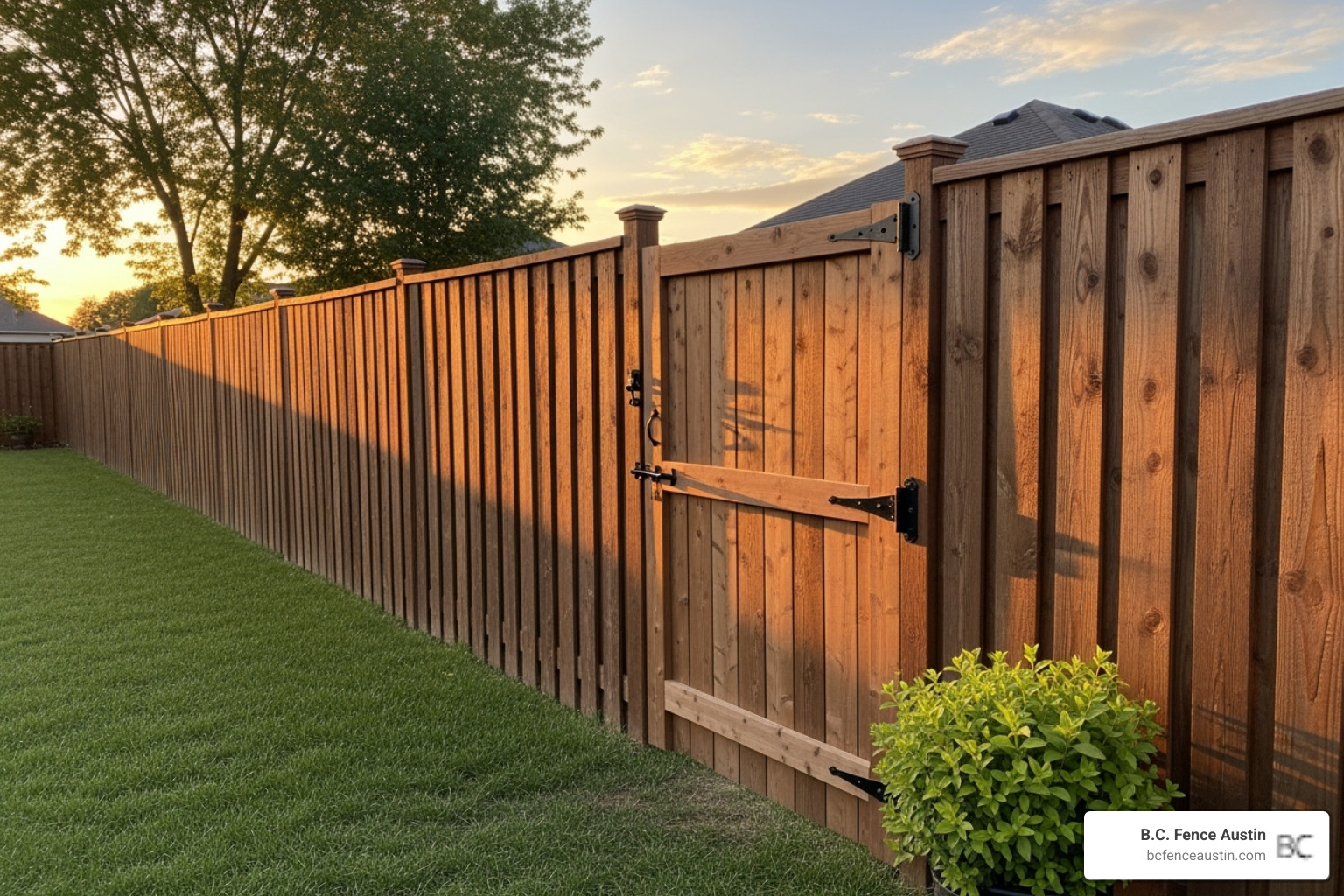
Site Preparation and Land Clearing
Before installation, your property must be prepared. This can involve more work than you might expect.
If you have an old fence, it will need to be removed completely, including demolition and hauling. Any trees, shrubs, or vegetation along the fence line must also be cleared.
In the Austin area, uneven ground or significant slopes may require grading to create a stable foundation. Rocky soil and limestone bedrock—common features in Cedar Park, Round Rock, and Leander—can make this process more challenging and labor-intensive.
Difficult terrain can increase the cost per linear foot due to the extra labor involved. We may need to “rack” or “step” the fence to follow the land’s natural contours, which requires specialized techniques.
Proper site preparation is essential to ensure your fence is structurally sound and looks great for years.
Gates, Permits, and HOA Fees
Gates are a necessary addition with their own costs. A simple walk-through gate is the most basic option. For vehicle access, a double-driveway gate requires wider spans and heavy-duty hardware. Automatic openers add convenience and increase the investment. We design gates that match your fence and meet your practical needs.
Before work begins, paperwork is necessary. Most municipalities around Austin require permits for fence installations, especially for taller privacy fences. Permits ensure compliance with local setback and height rules. We can help guide you through this process.
If you have a Homeowners’ Association (HOA), you’ll likely need its approval. HOAs have specific rules about fence height, materials, and styles, and may charge review fees. We have extensive experience working with local HOAs to ensure your design meets their guidelines.
Long-Term Maintenance and Lifespan
The true cost privacy fence 1 acre includes long-term maintenance.
Wood fences require regular attention. They need to be stained or sealed every few years to protect against moisture, UV rays, and insects. Neglecting this maintenance can dramatically shorten the fence’s lifespan.
In contrast, low-maintenance materials like vinyl, composite, and aluminum are practically hands-off. They resist rot, insects, and sun damage. A vinyl fence, for example, may only need an occasional rinse. This means no painting, sealing, or time-consuming weekend projects.
While low-maintenance materials often cost more upfront, they can save you significant money and time over the life of the fence. Choosing the right material now provides a better return on your investment and more time to enjoy your private outdoor space.
The Estimated Total Cost to Install a Privacy Fence on 1 Acre
So, what’s the bottom line? The cost privacy fence 1 acre is an investment range, not a fixed number. It’s shaped by your material selection, property characteristics, fence style, site preparation, and gate choices.
A budget-friendly treated pine fence on flat land will have a very different cost from a premium composite installation on a hilly lot with custom gates. This is why we provide custom quotes based on a professional assessment of your property.
How Regional Differences Impact the Cost Privacy Fence 1 Acre
Your location significantly impacts the cost privacy fence 1 acre. In the Austin market, several unique factors come into play.
The local cost of living and high demand for fencing in growing communities we serve—like Georgetown, Pflugerville, and Cedar Park—affect the market. More homeowners means more demand, which influences pricing.
Our region’s notorious limestone soil also plays a role. This rocky terrain requires specialized equipment and extra labor for post-hole digging, impacting installation costs.
Finally, contractor availability in a busy market affects the cost structure. Working with experienced local professionals ensures quality but is also a factor in regional pricing.
Understanding these Austin-specific nuances allows us to provide fair estimates that reflect the real-world conditions of your Central Texas property.
How to Save on the Cost Privacy Fence 1 Acre
Fencing a full acre is a substantial investment, but there are smart ways to manage the cost privacy fence 1 acre.
Material choices provide the biggest opportunity for savings. Treated pine and chain link with privacy slats are budget-friendly options that still deliver solid privacy. Our Ultimate Checklist for Affordable Fencing Options offers more ideas.
DIY site preparation can trim labor costs. If you’re handy, clearing minor brush or removing an old, simple fence are manageable tasks. However, be realistic about your capabilities, as some jobs require professional equipment.
Strategic timing can also help. Contractors may offer more favorable pricing during slower seasons like late fall or winter, though Texas weather can be a factor.
Phasing the installation is another practical approach. You can fence the most critical areas first (like the backyard) and complete the rest later as your budget allows.
Finally, get multiple quotes from reputable contractors to understand the market. The lowest price isn’t always the best value; prioritize quality materials, experienced installation, and reliable service for a project of this scale.
At B.C. Fence Austin, we are happy to work with you to find solutions that fit your budget and meet your goals. A simple conversation can often reveal new possibilities.
Frequently Asked Questions about Fencing a 1-Acre Lot
When planning a project as significant as fencing an entire acre, questions naturally arise. Here are the questions we hear most often about the cost privacy fence 1 acre.
What is the most affordable way to get privacy for a one-acre fence?
Fencing a full acre on a tight budget is possible with strategic choices.
Your two most budget-friendly options are chain link fencing with privacy slats and a pressure-treated pine wood fence. Chain link with slats provides a solid visual barrier at a lower cost than solid panels. The slats weave through the mesh, offering privacy while retaining the durability of chain link.
Treated pine is another economical choice that delivers genuine privacy with a classic look. Its upfront cost is lower than premium materials like vinyl, but it requires regular maintenance (staining or sealing) to protect it from the weather.
Both options effectively balance upfront cost with privacy needs. For more ideas, see our guide on the Most Affordable Privacy Fence Options.
How long does it take to install a fence around one acre?
Most professional crews can complete a one-acre fence installation in 4-7 days, but the specific timeline depends on several factors.
Terrain complexity is the biggest variable. Flat, accessible land allows for a smooth installation. However, slopes, rocky limestone soil, and difficult access points will extend the project timeline.
Weather can also cause delays. Rain is not just an inconvenience; it’s necessary to allow concrete to cure properly and to avoid working in muddy conditions that compromise quality.
Material availability and fence style also influence timing. Some materials install faster, while custom features like decorative tops or multiple gates add to the project duration.
We provide a realistic timeline during your consultation. An accurate estimate is better than an unrealistic promise, especially for a significant investment.
Does a privacy fence increase my property’s value?
Yes, a well-installed privacy fence increases property value. It’s a home improvement that offers immediate benefits and a return on investment when you sell.
A quality fence provides improved security, improved curb appeal, noise reduction, and clearly defined property lines. It also creates a private outdoor living space, effectively adding a usable “room” to your home.
For potential buyers, a beautiful fence signals that the home has been well-maintained. For families with children or pets, a fenced yard is often a “must-have” feature.
The return on investment varies, but a privacy fence consistently ranks as a top value-adding exterior improvement. In Austin-area communities where outdoor living is prized, this feature resonates strongly with buyers.
Beyond the financial return, the improved quality of life from added privacy and security is an immediate benefit.
Conclusion
You now have a clear picture of what shapes the cost privacy fence 1 acre. From perimeter measurements and material choices to labor, gates, and permits, every detail matters.
Fencing an acre is a significant investment. By understanding the cost drivers, you can make smart decisions that balance your budget with long-term goals. A well-built privacy fence creates a secure retreat, reduces noise, and adds value to your property.
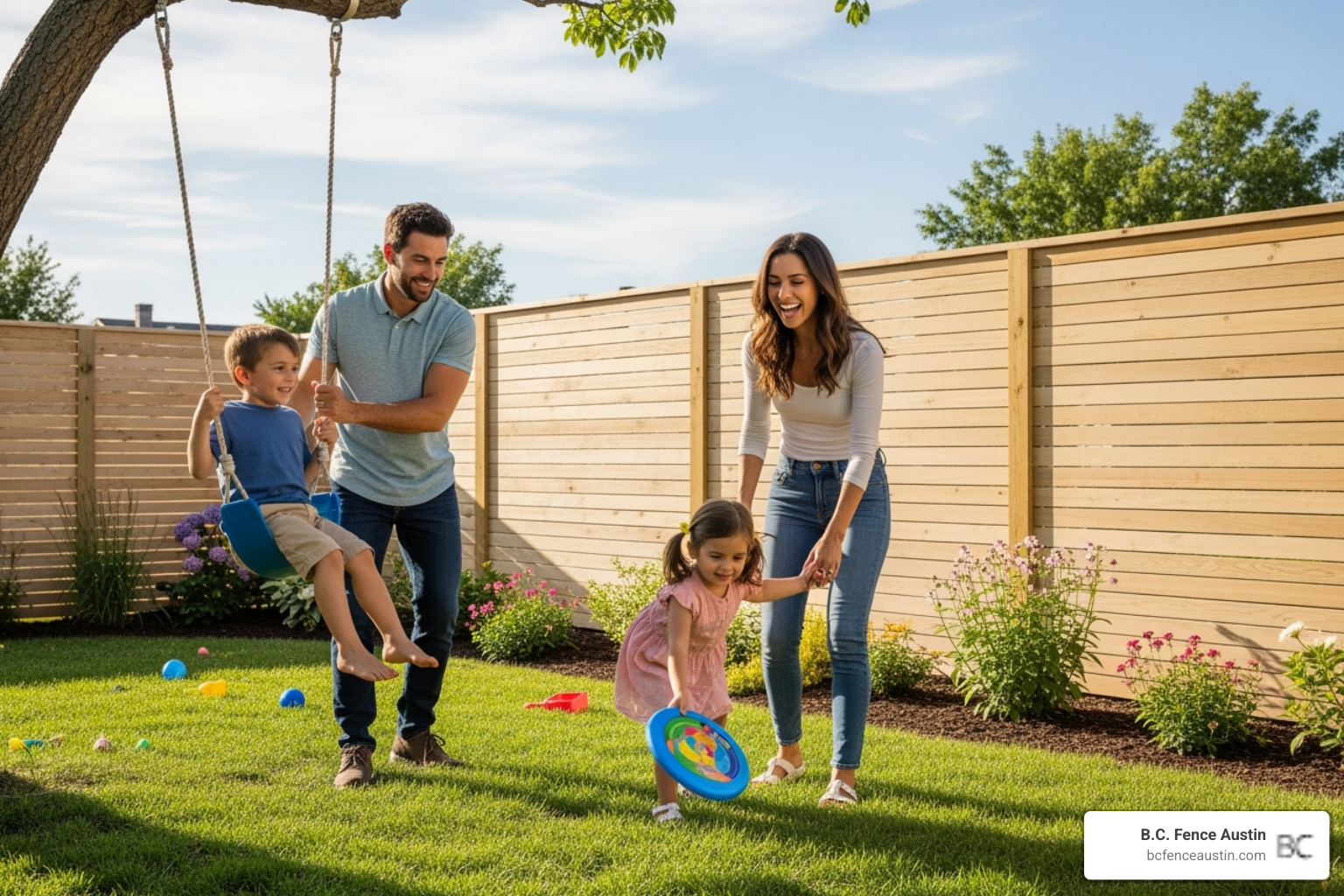
The cheapest option isn’t always the smartest. A pressure-treated pine fence saves money upfront but requires ongoing maintenance. A vinyl or composite fence costs more initially but saves time and money over its lifetime.
At B.C. Fence Austin, we help homeowners throughout Austin, Cedar Park, Round Rock, Leander, Georgetown, Pflugerville, and Avery Ranch create private havens. We understand the local terrain and regulations, providing transparent guidance and expert installation.
Every property is unique, which is why we provide detailed, custom quotes. We’ll assess your property, discuss your priorities, and give you an accurate project scope.
Ready to create your private outdoor space? Let’s discuss your vision. Explore your affordable privacy fence options with us today!
